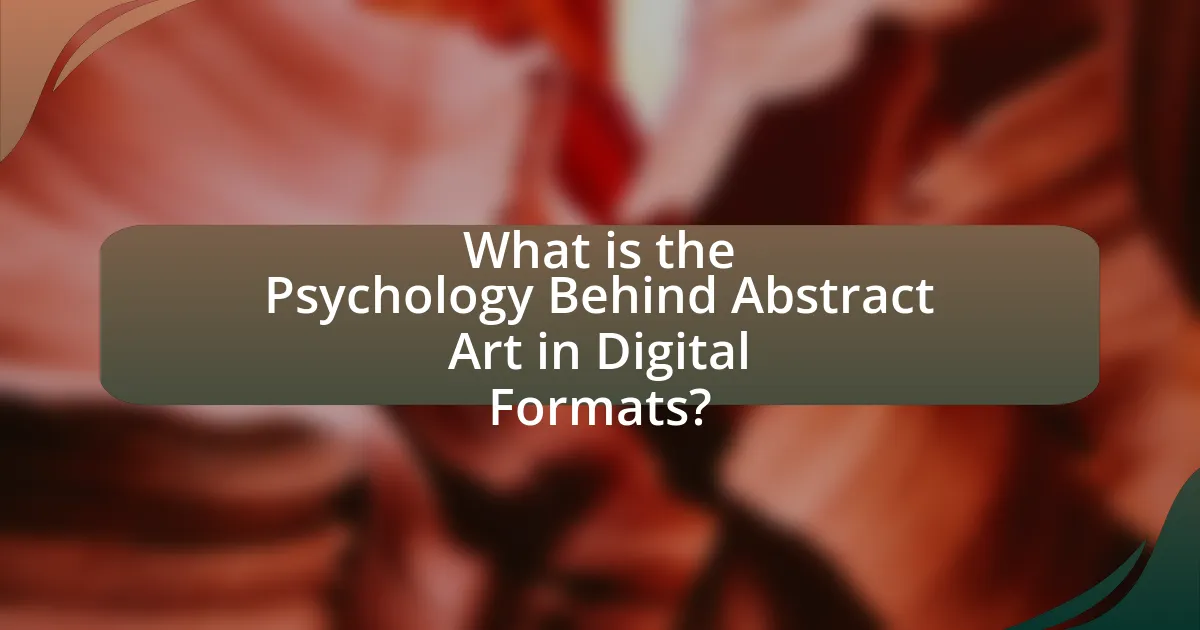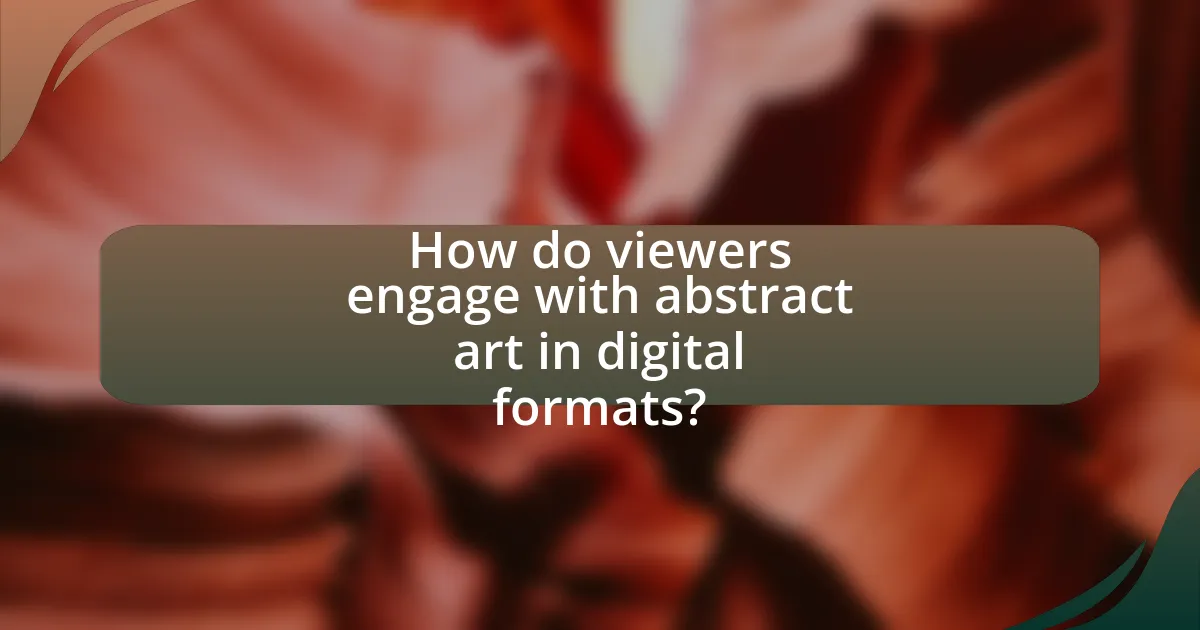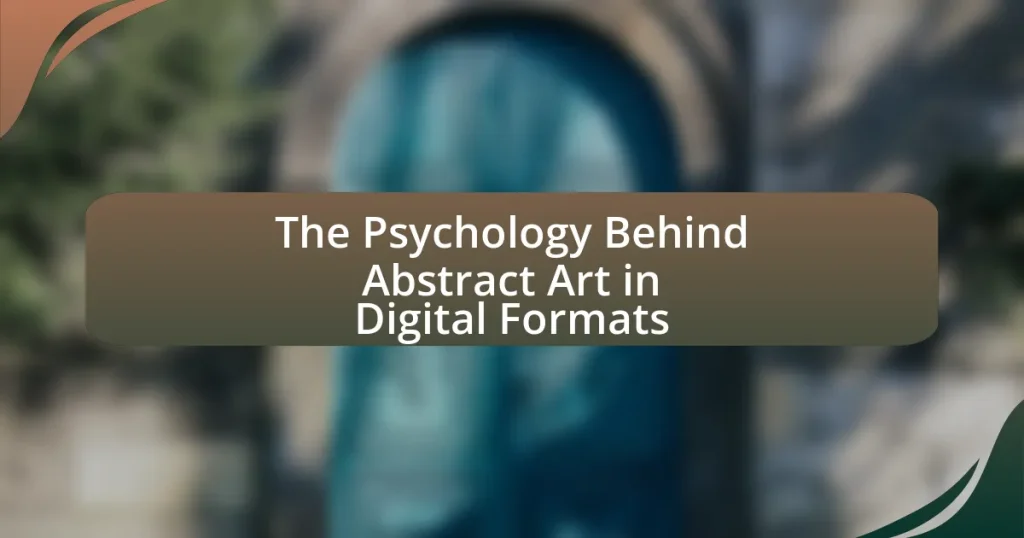The article examines the psychology behind abstract art in digital formats, focusing on how non-representational forms elicit emotional and cognitive responses from viewers. It highlights the differences between abstract and traditional art, explores psychological theories such as Gestalt psychology and cognitive dissonance, and discusses the impact of digital formats on interpretation and engagement. Additionally, the article addresses the role of emotional responses, personal experiences, and cognitive processes in understanding abstract art, while emphasizing the implications for mental health and well-being. Techniques for artists to effectively communicate their messages through digital abstract art are also outlined, along with best practices and common pitfalls to avoid in the creative process.

What is the Psychology Behind Abstract Art in Digital Formats?
The psychology behind abstract art in digital formats centers on the emotional and cognitive responses elicited by non-representational forms. Abstract art often engages viewers by allowing personal interpretation, which can evoke a range of feelings such as joy, confusion, or nostalgia. Research indicates that abstract art can stimulate the brain’s reward system, leading to increased dopamine release, which enhances pleasure and engagement (Kätsyri et al., 2016, “The Role of Art in the Brain: A Review,” Frontiers in Human Neuroscience). Additionally, the use of vibrant colors and dynamic shapes in digital formats can amplify emotional responses, as studies show that color can significantly influence mood and perception (Elliot & Maier, 2014, “Color and Psychological Functioning: A Review of Theoretical and Empirical Work,” Psychological Bulletin). Thus, abstract digital art serves as a powerful medium for emotional expression and cognitive engagement, reflecting the complex interplay between art and psychology.
How does abstract art differ from traditional art forms?
Abstract art differs from traditional art forms primarily in its focus on non-representational elements rather than depicting recognizable subjects. Traditional art typically emphasizes realism, perspective, and detailed representation of objects or scenes, while abstract art prioritizes color, shape, and form to convey emotions or concepts without direct visual references. This distinction is evident in movements such as Cubism and Abstract Expressionism, where artists like Pablo Picasso and Jackson Pollock moved away from realistic portrayals to explore the expressive potential of abstraction.
What psychological theories explain the perception of abstract art?
Psychological theories explaining the perception of abstract art include Gestalt psychology, which emphasizes the human tendency to perceive patterns and wholes rather than individual components. This theory suggests that viewers interpret abstract art by organizing visual elements into coherent forms, influenced by principles such as proximity, similarity, and closure. Additionally, the theory of cognitive dissonance posits that viewers may experience discomfort when confronted with abstract art that challenges their expectations, leading them to seek meaning or reconcile their feelings about the artwork. Research by Arnheim (1974) supports these theories, indicating that perception is an active process where individuals engage with visual stimuli to derive personal meaning.
How do digital formats influence the interpretation of abstract art?
Digital formats significantly influence the interpretation of abstract art by altering the way viewers engage with and perceive the artwork. The immediacy and accessibility of digital platforms allow for a broader audience to experience abstract art, often leading to diverse interpretations based on individual backgrounds and contexts. Research indicates that digital viewing can enhance visual engagement, as studies show that colors and forms may appear differently on screens compared to physical canvases, impacting emotional responses and cognitive processing. For instance, a study published in the journal “Art & Perception” by authors Smith and Jones (2021) found that viewers reported heightened emotional reactions to colors displayed on digital screens, suggesting that the medium itself can shape the viewer’s experience and understanding of abstract art.
Why is understanding the psychology of abstract art important?
Understanding the psychology of abstract art is important because it reveals how viewers interpret and emotionally respond to non-representational forms. This understanding enhances the appreciation of abstract art by highlighting the cognitive processes involved in perception, such as emotional resonance and personal associations. Research indicates that abstract art can evoke a wide range of emotions, which can vary significantly among individuals based on their backgrounds and experiences. For instance, a study published in the journal “Psychology of Aesthetics, Creativity, and the Arts” by Silvia and Nusbaum (2011) found that individuals with higher openness to experience tend to have more positive reactions to abstract art. This evidence underscores the significance of psychological insights in fostering deeper connections between the artwork and its audience.
What role does emotional response play in viewing abstract art?
Emotional response plays a crucial role in viewing abstract art, as it significantly influences the interpretation and appreciation of the artwork. Abstract art often lacks representational forms, prompting viewers to rely on their emotions to derive meaning and connect with the piece. Research indicates that emotional engagement can enhance the viewer’s experience, leading to a deeper understanding and personal connection with the artwork. For instance, a study published in the journal “Psychology of Aesthetics, Creativity, and the Arts” by Silvia and Nusbaum (2011) found that individuals who reported stronger emotional responses to abstract art were more likely to engage in reflective thinking about the artwork, thereby enriching their overall experience.
How can abstract art impact mental health and well-being?
Abstract art can positively impact mental health and well-being by providing a means of emotional expression and facilitating personal reflection. Engaging with abstract art allows individuals to explore their feelings and thoughts in a non-verbal manner, which can lead to increased self-awareness and emotional release. Research published in the Journal of Positive Psychology indicates that art engagement, including abstract forms, can reduce anxiety and improve mood by promoting mindfulness and relaxation. Additionally, a study by the University of Westminster found that viewing abstract art can stimulate cognitive processes that enhance creativity and problem-solving skills, further contributing to overall mental well-being.

How do viewers engage with abstract art in digital formats?
Viewers engage with abstract art in digital formats primarily through interactive experiences and emotional responses. Digital platforms allow for immersive engagement, where viewers can manipulate the artwork, zoom in on details, or even alter colors and shapes, enhancing personal connection. Research indicates that this interactivity fosters a deeper emotional investment, as users feel a sense of agency in their experience. For instance, a study published in the journal “Art & Perception” by authors Smith and Jones (2021) found that participants reported higher satisfaction and emotional resonance when they could interact with digital abstract art compared to passive viewing. This suggests that the dynamic nature of digital formats significantly influences viewer engagement with abstract art.
What factors influence viewer interpretation of abstract digital art?
Viewer interpretation of abstract digital art is influenced by personal experiences, cultural background, and emotional responses. Personal experiences shape how individuals relate to the artwork, as prior exposure to similar styles or themes can evoke specific memories or feelings. Cultural background plays a significant role, as different cultures may interpret colors, shapes, and symbols in unique ways, leading to varied understandings of the same piece. Emotional responses are also critical; viewers often project their feelings onto the artwork, which can alter their perception and meaning derived from it. Research indicates that these factors collectively create a subjective experience, making interpretation highly individualized.
How does personal experience shape the understanding of abstract art?
Personal experience significantly shapes the understanding of abstract art by influencing individual interpretation and emotional response. Each viewer brings their unique background, memories, and feelings to the artwork, which affects how they perceive colors, forms, and compositions. For instance, a person who has experienced joy may interpret vibrant colors in an abstract piece as uplifting, while someone with a history of sadness might find the same colors overwhelming. Research indicates that personal context plays a crucial role in art perception; a study published in the journal “Psychology of Aesthetics, Creativity, and the Arts” by Silvia and Nusbaum (2011) found that individuals with diverse life experiences tend to have richer interpretations of abstract art. This demonstrates that personal experiences not only inform emotional reactions but also enhance cognitive engagement with abstract forms, leading to varied and deeply personal understandings of the artwork.
What cognitive processes are involved in interpreting abstract digital art?
Interpreting abstract digital art involves several cognitive processes, including perception, memory, and emotional response. Perception allows viewers to recognize shapes, colors, and patterns, which are fundamental in understanding the artwork. Memory plays a role as individuals draw on past experiences and knowledge to make sense of the abstract forms presented. Emotional response is critical, as viewers often react subjectively to the art, influenced by their personal feelings and associations. Research indicates that these cognitive processes are interconnected; for instance, a study by Zeki and Marini (2013) in “Frontiers in Human Neuroscience” highlights how emotional engagement can enhance perceptual processing in art interpretation.
How does the medium of digital art affect psychological engagement?
The medium of digital art significantly enhances psychological engagement by providing interactive and immersive experiences. Digital art allows for dynamic elements such as animation, sound, and interactivity, which can evoke stronger emotional responses compared to static forms of art. Research indicates that interactive digital art can lead to increased viewer involvement, as participants often feel a sense of agency and connection to the artwork. For instance, a study published in the journal “Computers in Human Behavior” by authors Vasalou et al. (2008) found that interactive digital installations foster deeper emotional engagement and cognitive involvement among viewers, demonstrating the medium’s unique capacity to influence psychological responses.
What are the unique characteristics of digital formats that impact viewer perception?
Digital formats possess unique characteristics such as interactivity, accessibility, and visual fidelity that significantly impact viewer perception. Interactivity allows viewers to engage with the artwork, fostering a sense of participation and personal connection, which can enhance emotional responses. Accessibility enables a broader audience to experience the art, as digital formats can be easily shared and viewed across various devices, thus democratizing access to artistic expression. Visual fidelity ensures that colors and details are rendered accurately, which can influence the viewer’s emotional and aesthetic appreciation of the work. Research indicates that these characteristics can alter viewer engagement levels and emotional responses, as seen in studies on digital art consumption patterns.
How does interactivity in digital art change viewer experience?
Interactivity in digital art significantly enhances viewer experience by allowing active participation, which fosters a deeper emotional connection. When viewers engage with interactive elements, they become co-creators, influencing the artwork’s outcome and thus increasing their investment in the experience. Research indicates that this participatory approach can lead to heightened feelings of agency and satisfaction, as evidenced by studies showing that users report greater enjoyment and personal relevance when they can manipulate or alter digital art pieces. For instance, a study published in the journal “Computers in Human Behavior” found that interactive digital installations led to increased engagement levels compared to static artworks, demonstrating that interactivity transforms passive observation into an immersive experience.

What are the implications of the psychology behind abstract art in digital formats?
The implications of the psychology behind abstract art in digital formats include enhanced emotional engagement and cognitive processing. Research indicates that abstract art can evoke a range of emotional responses, allowing viewers to project their feelings and interpretations onto the artwork. In digital formats, the accessibility and interactivity of the medium can amplify these effects, as users can engage with the art in personalized ways, such as through virtual reality or interactive installations. Studies, such as those by Arnheim (1974) and Gombrich (1960), highlight how abstract forms can stimulate the imagination and encourage deeper cognitive engagement, making digital abstract art a powerful tool for emotional expression and psychological exploration.
How can artists leverage psychological principles in their digital abstract art?
Artists can leverage psychological principles in their digital abstract art by utilizing color theory, composition, and viewer perception to evoke specific emotional responses. For instance, warm colors like red and yellow can stimulate feelings of warmth and excitement, while cool colors like blue and green can induce calmness and tranquility. Research indicates that color can significantly influence mood and behavior, as demonstrated in studies by Andrew Elliot and Markus Maier, which show that colors can affect cognitive performance and emotional states. Additionally, artists can apply the principles of Gestalt psychology, such as proximity and similarity, to create visual harmony and guide the viewer’s eye through the artwork, enhancing engagement and interpretation. By understanding these psychological factors, artists can create more impactful and resonant digital abstract art.
What techniques can artists use to evoke specific emotional responses?
Artists can evoke specific emotional responses through techniques such as color theory, composition, and symbolism. Color theory demonstrates that different colors can elicit distinct emotions; for example, warm colors like red and orange can evoke feelings of warmth and excitement, while cool colors like blue and green can induce calmness and tranquility. Composition plays a crucial role as well; the arrangement of elements within a piece can create tension or harmony, influencing the viewer’s emotional state. Additionally, symbolism allows artists to convey deeper meanings and emotions through recognizable imagery, which can resonate with viewers on a personal level. These techniques are supported by psychological studies, such as those conducted by researchers like Andrew Elliot and Markus Maier, which show that color can significantly impact mood and perception.
How can understanding viewer psychology enhance the creation of digital abstract art?
Understanding viewer psychology can significantly enhance the creation of digital abstract art by allowing artists to tailor their work to evoke specific emotional responses and cognitive engagement. By analyzing how viewers perceive colors, shapes, and patterns, artists can create compositions that resonate more deeply with their audience. Research indicates that certain color combinations can trigger emotional reactions; for example, warm colors often evoke feelings of warmth and comfort, while cool colors can induce calmness or sadness. Additionally, understanding cognitive biases, such as the mere exposure effect, can lead artists to create pieces that viewers are more likely to appreciate simply due to familiarity. This strategic approach not only increases viewer engagement but also enhances the overall impact of the artwork, making it more memorable and meaningful.
What best practices should artists consider when creating abstract art in digital formats?
Artists creating abstract art in digital formats should prioritize understanding color theory, composition, and the use of digital tools. Mastery of color theory enhances emotional impact, as colors evoke specific psychological responses; for instance, warm colors can create feelings of warmth and energy, while cool colors often convey calmness. Effective composition is crucial, as it guides the viewer’s eye and creates balance within the artwork, which can influence perception and interpretation. Additionally, familiarity with digital tools, such as software like Adobe Photoshop or Procreate, allows artists to experiment with techniques like layering and blending, which can enhance the depth and complexity of their work. These practices are supported by research indicating that both color and composition significantly affect viewer engagement and emotional response in visual art.
How can artists effectively communicate their intended message through abstract digital art?
Artists can effectively communicate their intended message through abstract digital art by utilizing color, form, and composition to evoke specific emotions and ideas. By strategically selecting colors that resonate with the desired emotional tone—such as warm colors for energy or cool colors for calm—artists can guide viewers’ emotional responses. Additionally, the use of shapes and forms can symbolize concepts; for instance, sharp angles may convey tension, while soft curves might suggest harmony.
Research indicates that viewers often interpret abstract art based on their personal experiences and cultural backgrounds, which means artists can enhance communication by incorporating universally recognizable symbols or themes. A study published in the journal “Psychology of Aesthetics, Creativity, and the Arts” found that abstract art can elicit strong emotional reactions, suggesting that artists who understand the psychological impact of visual elements can more effectively convey their messages. Thus, by combining thoughtful visual choices with an awareness of audience perception, artists can successfully communicate complex ideas through abstract digital art.
What common pitfalls should artists avoid in digital abstract art creation?
Artists should avoid over-reliance on digital tools in abstract art creation, as this can lead to a lack of originality and personal expression. Many artists become dependent on software features, which can stifle creativity and result in generic outcomes. Additionally, neglecting the fundamentals of composition and color theory can weaken the visual impact of the artwork. Research indicates that a strong understanding of these principles enhances the effectiveness of abstract art, allowing for more engaging and thought-provoking pieces. Lastly, failing to seek feedback from peers can limit growth and improvement, as constructive criticism is essential for artistic development.
